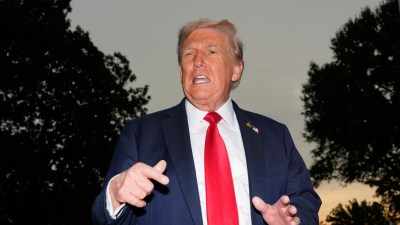
It is little coincidence then that the manner in which the three parties utilised the MLA-LAD funds available to them also reflects the party’s strategies for the upcoming election.
Story continues below this ad
While the BJP is relying heavily on the image of its Prime Minister Narendra Modi, its main thrust remains the promise of development. Mirroring this, the BJP MLAs utilised their funds for infrastructure development, particularly the construction of roads and enhancement of power and water network.

The Congress MLAs too, like their BJP counterparts, had preferred to fall back on the age-old reliable formula of roads, power and water. But after their humiliating defeat in the 2013 Assembly election, they knew only too well that it was the continued support of minority communities, particularly the Dalits and the Muslims, which had helped the party retain at least eight seats in the Delhi Assembly.
So, while some chose to spend their funds safely — such as Delhi Congress chief Arvinder Singh Lovley who spent his development funds exclusively on the improvement of roads — the Congress’s minority leaders spent their funds on projects intended for the welfare of the minority communities.
The AAP MLAs spent their funds in keeping the party’s motto of a ‘fresh’ kind of politics.
Story continues below this ad
AAP legislators utilised their funds in the broadest way possible covering projects ranging fromconstruction of skating rinks, giving relief to the victims of the Kashmir flood and setting up of CCTV cameras in market places. But while the party is keen to innovate, like the Congress, it too hasn’t forgotten its primary support base — the minorities and Dalits.
AAP chief Arvind Kejriwal, for instance, defeated Sheila Dikshit from the New Delhi Assembly seat. The feat, which had till then been thought of as impossible, was due to the support he received from the JJ colonies and urban villages that dot the Assembly segment.
Apart from using his MLA-LAD funds for developing roads and the markets in the posh Assembly, Kejriwal has also spent Rs 36.45 lakh on installing deep-well pumps and water hydrants in JJ clusters in the area, including the one behind PM Narendra Modi’s Race Course Road residence.
While it was BJP’s R K Puram MLA Anil Sharma who took the first step towards utilising development funds for the installation of CCTV cameras after the December 16 gangrape incident, it was the AAP which took the project forward. With CCTV cameras now a part of their election manifesto, AAP MLAs Bandana Kumari and Rakhi Birla, for instance, spent nearly Rs 1 crore on installation of CCTV cameras.
Story continues below this ad
With the AAP attempting to make inroads into Outer Delhi — a BJP bastion — the BJP is banking the spending of its MLAs to retain its in this segment.
BJP MLA from Najafgarh Ajit Singh Kharkari has spent Rs 1.80 crore on the construction of roads in the rural portions of the Assembly. “The area is agrarian and roads are needed for farmers to transport their goods to markets in Delhi and Haryana,” a senior BJP leader said.
Dalits, Muslims benefit most from kitty
The Congress had openly cited the erosion of its traditional support base — the Dalits and the Muslims — as the “prime reason” for its humiliating defeat in the 2013 Delhi Assembly elections. It came as no surprise then that the Congress MLAs directed a major chunk of their development funds towards projects aimed at the welfare of these communities.
Pointing out that the Congress had not directly allocated funds to the minorities, a senior leader said, “We want Muslims and Dalits to realise that we are still the best option to ensure that a secular government comes to power.”
For instance, Congress leader and Ballimaran MLA Haroon Yusuf spent Rs 68.97 lakh on the construction of roads, most of them located in the proximity of mosques and dargahs that dot his Assembly segment.
Story continues below this ad
In Badli, Devender Yadav — who won the 2013 Assembly elections due to the support he received from the large Muslim population in the seat — spent Rs 13.54 lakh for “the improvement of Muslim quadimi kabaristan and Madina Masjid”.
Hasan Ahmed, Congress MLA from Seemapuri, spent Rs 11.91 lakh on the repair of the kabaristan in his Assembly constituency. Another Rs 2.1 lakh was spent on the Idgah road at Seemapuri. Interestingly, Ahmed has also spent Rs 1.05 crore on the construction of a drainage facility around the renowned Kabir Mandir in his Assembly segment.
The AAP too adopted a similar approach of “indirect allocations”.
Most AAP MLAs allocated funds for the construction of “Harijan choupals” and for improving the roads near Valmiki temples.
Former AAP minister and Greater Kailash MLA Saurabh Bhardwaj spent Rs 6.51 lakh on the construction of a “welcome gate” at the Valmiki temple in his Assembly seat.
Story continues below this ad
Prakash Jarwal, AAP MLA from Deoli, invested Rs 1.07 crore for the construction of a Valmiki Chaupal in his Assembly segment.
The BJP too was not far behind when it came to spending on Dalits.
They also adopted a development plank of investing in Harijan choupals and specific infrastructure for the welfare of the Dalit community.
BJP MLA from Rajinder Nagar, for instance, spent Rs 9 lakh on the construction of a boundary wall and a road outside the Valmiki temple in his Assembly.
Story continues below this ad
“The BJP is looking to get as many Dalit votes as possible, especially in the reserved seats. We want them to realise that voting for Modi is equivalent to voting for development,” a senior BJP leader said.








